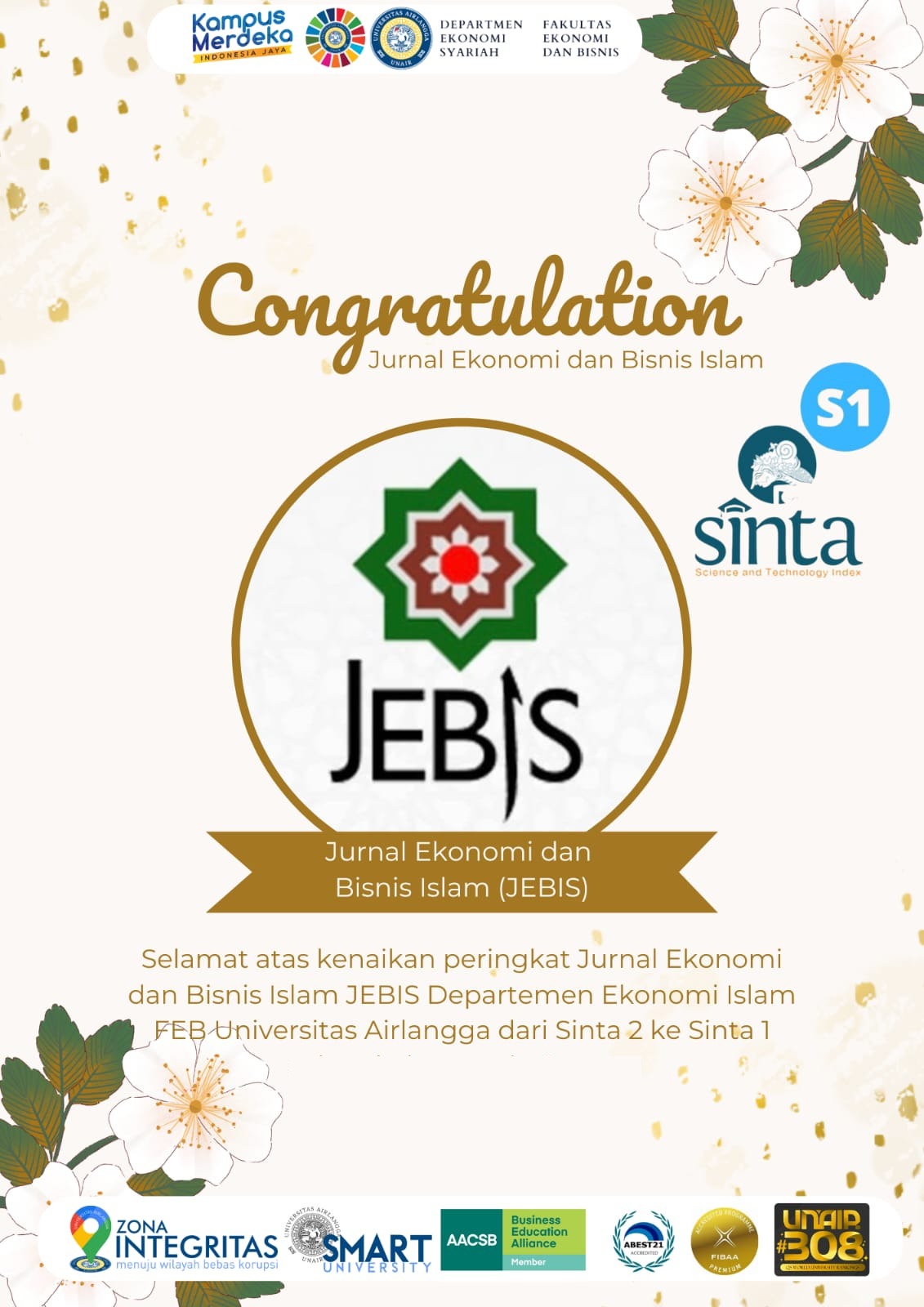RISK OF RETURN CHARACTERISTICS OF ISLAMIC BANK FINANCING PORTFOLIO IN INDONESIA
Downloads
Ahmad, N. H., & Ahmad, S. N. (2004). Key Factors Influencing Credit Risk of Islamic Bank: a Malaysian Case. Journal of Muamalat and Islamic Finance Research (JMIFR), 1(1). http://ddms.usim.edu.my/handle/123456789/5298
Akram, H., & Rahman, K. ur. (2018). Credit Risk Management: A Comparative Study of Islamic Banks and Conventional Banks in Pakistan. ISRA International Journal of Islamic Finance, 10(2), 185–205. https://doi.org/10.1108/IJIF-09-2017-0030
Al-Foul, L. R. A. (2017). Forecasting Asset Covariances and Variances based on Multi-Scale Risk Models on Portofolio Optimization Evidence from Amman Stock Exchange (ASE) [Yarmouk University]. http://repository.yu.edu.jo/bitstream/123456789/14083/1/675115.pdf
Badan Pusat Statistik. (2020). Analisis Hasil Survei Dampak Covid-19 terhadap Pelaku Usaha. https://www.bps.go.id/publication/2020/09/15/9efe2fbda7d674c09ffd0978/analisis-hasil-survei-dampak-covid-19-terhadap-pelaku-usaha.html
Butler, C. (1999). Mastering Value at Risk: A Step-by-step Guide to Understanding and Applying VaR. Financial Times/Prentice Hall.
Chamberlain, T., Hidayat, S., & Khokhar, A. R. (2020). Credit Risk in Islamic Banking: Eidence from the GCC. Journal of Islamic Accounting and Business Research, 11(5), 1055–1081. https://doi.org/10.1108/JIABR-09-2017-0133
Chowdhury, M. A. F., Shoyeb, M., Akbar, C., & Islam, M. N. (2016). Risk Sharing Paradigm of Islamic Banks: Case of Bangladesh. In D. S. Mutum, M. M. Butt, & M. Rashid (Eds.), Advances in Islamic Finance, Marketing, and Management (pp. 103–130). Emerald Group Publishing Limited. https://doi.org/10.1108/978-1-78635-899-820161007
Dewi, V. I. (2013). Asset Allocation: Diversification dan Rebalancing sebagai Bagian dari Proses Perencanaan Keuangan (Suatu Kajian Pustaka). Bina Ekonomi, 17(1). https://doi.org/10.26593/be.v17i1.805.%25p
Errico, L., & Sundararajan, V. (2002). Islamic Financial Institutions and Products in the Global Financial System: Key Issues in Risk Management and Challenges Ahead (02/192). https://papers.ssrn.com/sol3/papers.cfm?abstract_id=1930788
Fakhfekh, M., Hachicha, N., Jawadi, F., Selmi, N., & Cheffou, A. I. (2016). Measuring Volatility Persistence for Conventional and Islamic Banks: An FI-EGARCH Approach. Emerging Markets Review, 27(June 2016), 84–99. https://doi.org/10.1016/j.ememar.2016.03.004
Ferhi, A. (2018). Credit Risk and Banking Stability: A Comparative Study between Islamic and Conventional Banks. International Journal of Law and Management, 60(4), 1009–1019. https://doi.org/10.1108/IJLMA-05-2017-0112
Grassa, R. (2012). Islamic Banks' Income Structure and Risk: Evidence from GCC Countries. Accounting Research Journal, 25(3), 227–241. https://doi.org/10.1108/10309611211290185
Hanif, M. (2016). Economic Substance or Legal Form: An Evaluation of Islamic Finance Practice. Iternational Journal of Islamic and Middle Eastern Finance and Management, 9(2), 277–295. https://doi.org/10.1108/IMEFM-07-2014-0078
Haron, A., & Hock, J. L. H. (2012). Inherent Risk: Credit and Market Risks. In S. Archer & R. A. A. Karim (Eds.), Islamic Finance: The Regulatory Challenge (pp. 94–120). Wiley. https://doi.org/10.1002/9781118390443.ch5
Ikatan Bankir Indonesia. (2018). Memahami Bisnis Bank Syariah. Gramedia Pustaka Utama.
Iqbal, Z., & Mirakhor, A. (2011). An Introduction to Islamic Finance: Theory and Practice. John Wiley and Sons.
Ismal, R. (2010). Volatility of the Returns and Expected Losses of Islamic Bank Financing. International Journal of Islamic and Middle Eastern Finance and Management, 3(3), 267–279. https://doi.org/10.1108/17538391011072453
Ismal, R. (2014). An optimal risk – return portfolio of Islamic banks. Humanomics, 30(4), 286–303. https://doi.org/10.1108/H-08-2013-0055
Kabir, M. N., Worthington, A., & Gupta, R. (2015). Comparative Credit Risk in Islamic and Conventional Bank. Pacific-Basin Finance Journal, 34(September), 327–353. https://doi.org/10.1016/j.pacfin.2015.06.001
Louhichi, A., & Boujelbene, Y. (2016). Credit Risk, Managerial Behaviour and Macroeconomic Equilibrium within Dual Banking Systems: Interest-Free vs. Interest-Based Banking Industries. Research in International Business and Finance, 38(September), 104–121. https://doi.org/10.1016/j.ribaf.2016.03.014
Masood, O., Al-Suwaidi, H., & Thapa, P. D. P. (2012). Credit Risk Management: A Case Differentiating Islamic and Non"Islamic Banks in UAE. Qualitative Research in Financial Markets, 4(2/3), 197–205. https://doi.org/10.1108/17554171211252529
Mokni, R. B. S., Rajhi, M. T., & Rachdi, H. (2016). Bank Risk-taking in the MENA Region: A Comparison between Islamic Banks and Conventional Banks. International Journal of Social Economics, 43(12), 1367–1385. https://doi.org/10.1108/IJSE-03-2015-0050
Obaidullah, M. (2005). Islamic Financial Services (1st ed.). Scientific Publishing Centre King Abdulaziz University.
Otoritas Jasa Keuangan. (2018). Statistik Perbankan Syariah - Desemer 2017. https://www.ojk.go.id/id/kanal/syariah/data-dan-statistik/statistik-perbankan-syariah/Pages/Statistik-Perbankan-Syariah---Desember-2017.aspx
Otoritas Jasa Keuangan. (2021). Statistik Perbankan Syariah -
Rosly, S. A., & Zaini, M. A. M. (2008). Risk"return Analysis of Islamic Banks' Investment Deposits and Shareholders' Fund. Managerial Finance, 34(10), 695–707. https://doi.org/10.1108/03074350810891010
Sari, A. P. N., & Purwanto, A. (2012). Analisis Kebijakan Alokasi Aset, Kinerja Manajer Investasi dan Tingkat Risiko terhadap Kinerja Reksadana Saham di Indonesia [Diponegoro University]. http://eprints.undip.ac.id/36200/
Shahari, F., Zakaria, R. H., & Rahman, M. S. (2015). Investigation of the Expected Loss of Sharia Credit Instruments in Global Islamic Banks. International Journal of Managerial Finance, 11(4), 503–512. https://doi.org/10.1108/IJMF-12-2014-0196
Tan, T.-K., & Lakehal-Ayat, M. (2018). A Big Data Bayesian Approach to Earnings Profitability in the S&P 500. PSU Research Review, 2(1), 35–58. https://doi.org/10.1108/PRR-04-2017-0023
Tariqullah, K., & Habib, A. (2001). Risk Management: An Analysis of Issues in Islamic Financial Industry (Occasional Papers). Occasional Papers. https://ideas.repec.org/p/ris/irtiop/0091.html
Warninda, T. D., Rofikoh, R., & Ekaputra, I. A. (2019). Islamic Bank Profit-Loss Sharing Financing and Earnings Volatility. Social Sciences and Humanities, 27(S2), 229–239.
Copyright (c) 2021 JEBIS (Jurnal Ekonomi dan Bisnis Islam)

This work is licensed under a Creative Commons Attribution-NonCommercial-ShareAlike 4.0 International License.
- Every manuscript submitted to JEBIS must obey to the policy and terms set by Journal of Economics and Business Islamic.
- Publication rights on the contents of manuscript published by JEBIS is owned by JEBIS under consent and approval by the corresponding author(s).
- Full text of electronic publication of manuscripts can be accessed free if used for the purpose of education and research according to copyright regulation.
- Share ” copy and redistribute the material in any medium or format
- Adapt ” remix, transform, and build upon the material
- You must give appropriate credit, provide a link to the license, and indicate if changes were made. You may do so in any reasonable manner, but not in any way that suggests the licensor endorses you or your use.
- You may not use the material for commercial purposes.
- If you remix, transform, or build upon the material, you must distribute your contributions under the same license as the original.
Creative Commons Attribution-NonCommercial-ShareAlike 4.0 International License.





.png)














